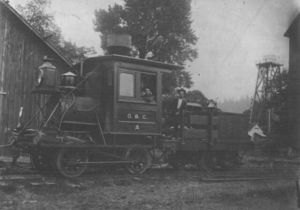Oregon and California Railroad
The Oregon and California Railroad was formed from the Oregon Central Rail Road when it was the first to operate a 20 mile stretch south of Portland in 1869. This qualified the Railroad for land grants in California, whereupon the name of the railroad soon changed to Oregon & California Rail Road Company. In 1887, Southern Pacific assumed control of the railroad, although it was not officially sold to Southern Pacific until January 3, 1927.
Contents
History
Grant of public lands
In all, the O&C received grants in the 1860s to about 4 million acres of forestland in western Oregon in exchange for the construction of a railroad from Portland to the California border, on the grounds that the development of such a line was in the public interest. Under the provisions of the grant, as construction progressed, the O&C Railroad earned the right to sections of land in strips 20 miles wide on alternating sides of the constructed tracks. The public lands transferred to the company created a checkerboard pattern. The railroad was required by Congress to offer the grant lands for sale to "actual settlers," in parcels no greater than 160 acres, and at prices limited to a maximum of US$2.50 per acre. These purpose of these restrictions was to encourage settlement and economic development, while compensating the O&C Railroad for its costs of construction. Construction efforts were sporadic, finally reaching completion in 1887 after the financially troubled O&C Railroad was acquired by the Southern Pacific.[1]
Mismanagement and fraud
While construction was still ongoing, multiple charges of land fraud arose. The company was accused of rounding up individuals from saloons in Portland's waterfront district, and paying them to sign applications to purchase 160 acre parcels of O&C lands as "settlers," then selling these fraudulent instruments in large blocks to corporate interests through corrupt middlemen. This elaborate money laundering and land fraud scheme was only the beginning. Southern Pacific Railroad eventually abandoned the pretense of nonexistant settlers, and sold lands in large parcels directly to developers for as much as US$40 per acre. By 1902, with land prices soaring, company declared it was terminating land sales altogether. When the scandal broke in 1904 through an investigation by The Oregonian it had grown to such a magnitude that the paper reported that more than 75% of the land sales had violated federal law.[1]
President Roosevelt intervenes
Newly elected President Theodore Roosevelt, as part of his plan of progressive reforms, vowed in 1903 to "clean up the O&C land fraud mess, once and for all!" Over the following two years, Roosevelt’s investigators collected evidence, and over 1,000 politicians, businessmen, railroad executives and others were indicted. Many were eventually tried and convicted on charges including fraud, bribery and other corruption. The federal government sought return of the grant lands from the railroad not actually part of the right of way for the railroad line itself.[1]
Case goes to Supreme Court
In 1915, the U.S. Supreme Court decided that the railroad had been built as promised, so the railroad company should not be forced to completely forfeit the lands, despite having violated the terms of the grant. Congress responded in 1916 by taking back the lands, but compensating the company at an amount equivalent to what it would have received had it abided by the $2.50 per acre limit.[1]
That result was that over 2 million acres were recovered, removing them from private control and back into federal ownership. As of 2006, their retention by the federal government, and therefore not subject to local and state taxation, remains a political issue.[1]
References
- ↑ 1.0 1.1 1.2 1.3 1.4 Transcript of The History of the O&C or Saving Oregon's Future (PDF). Jackson County, Oregon (Official website). Jackson County, Oregon (200). Retrieved on 2006-12-11.

